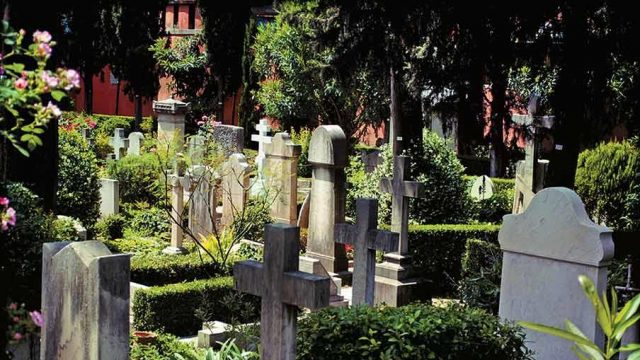In Peter Stanford’s book, the humane and delicate How to Read a Graveyard, he describes his visits to ten cemeteries around the world. These include a mix of the famous and surprising — from Père Lachaise in Paris, resting place of Oscar Wilde and Jim Morrison, to the small and lesser-known Chiltern Woodland Burial Park, an eco-friendly ‘forest of remembrance’ in Buckinghamshire. Amid his musings, he also speaks of my favourite place of internment (if one is allowed such things without sounding too morbid) — the Cimitero Acattolico in Rome. Usually known in English as the Protestant or Non-Catholic cemetery, the word ‘acattolico’ is better translated as ‘acatholic,’ in the sense of apolitical or asexual, to be removed or not involved. This is more fitting, for among the dead here lie Hindus, Jews, Buddhists, Zoroastrians and Orthodox Christians.
If you tire of the Eternal City’s perpetual tourist-filled streets, it’s best to head out of the crowded Centro Historico. Wander away from the Colosseum, down Viale Aventino’s wide sidewalks towards the Pyramid of Cestius, passing by busy cafés and restaurants, clusters of half-excavated Roman ruins, houses overhung with flowers and a small park dotted with old men playing cards. Cimitero Acattolico is located beyond the walls of Imperial Rome, off the main road, its entrance in a quiet side street, often and easily missed. It lies nestled on a gentle slope in the shadow of the Pyramid of Gaius Cestius, a member of one of the ruling families of Rome, who sat on various august governing bodies. He died between 18 and 12 BC, immortal now, perhaps, for nothing more than this strange and striking forty-metre-high mausoleum. The cemetery is also adjacent to a section of Rome’s ancient Aurelian wall, built between AD 271 and 275 during the reign of Roman emperors, Aurelian and Probus.
It is as Stanford says, that the cemetery conjures up pairidaeza — the walled garden of ancient Persian kings, an oasis of shade and beauty in an otherwise parched and exhausting landscape, that is the origin of the word ‘paradise’ and blueprint for Christian imaginings of heavenly after-life. When I walked in, on a warm, sunny afternoon in May, what struck me were the towering cypress trees, trailing leaves and flowers in full bloom. A gardener with a hose ambled by, while to the left stood a small information centre, manned by a couple of helpful elderly ladies. The cemetery is partitioned into two distinct sections — pre- and post-legalization in 1821, when the Secretary of State to Pope Pius VII gave the stamp of official approval to the burial ground that had already existed there for a century. The cemetery, in use since the 1730s, is one of the oldest graveyards in continuous use in Europe. The earliest surviving grave is of an Oxford graduate named George Langton, who died at twenty-five in 1738.
Apart from escaping the crowds, I had other motives for visiting Cimitero Acattolico. The cemetery is often considered Rome’s unofficial ‘poet’s corner,’ resting place for numerous writers, artists and intellectuals. The most famous of these are English poets John Keats and Percy B. Shelley and Italian political thinker Antonio Gramsci. Being a fan of all three, I set out on a propitiatory quest armed with bouquets of wild violets I’d plucked in the park. Keats is buried in the old ‘Parte Antica,’ an airy, grassy meadow that borders Cestius’ pyramid. The young poet travelled to Rome in 1821, suffering from consumption, in the hope that Italy’s warmer climes would help improve his health and spirits. He died in an apartment above the Spanish Steps and was buried in a place that his friend Joseph Severn described as ‘the most lovely retired spot’ in the city. His grave isn’t easy to find — tucked away in the farthest corner, turning its back on the world. The simple tomb carries an epitaph the poet wished it to, heartbroken by his failure then to make a mark in the literary world: ‘Here lies one whose name was writ in water.’
Since Shelley wrote, ‘It might make one in love with death, to think that one should be buried in so sweet a place’ about Cimitero Acattolico, it may be safe to assume he found peace at his resting place here. He drowned in 1822, off the coast of Tuscany, and his ashes lie buried in the ‘new’ section of the cemetery, close to the top of the slope, bordered by a high wall. The tombstone is a plain, pale rectangular slab, laid flat on the ground. The inscription, too, is simple, taken from Shelley’s favourite play The Tempest, a few lines of ‘Ariel’s Song’ in reference to his death at sea: ‘Nothing of him that doth fade/But doth suffer a sea-change/Into something rich and strange.’ Nearby, stands American sculptor William Story’s moving creation for the grave of his wife Emelyn, both long-term residents of Rome. The life-size angel drapes itself over her tomb, weeping. The details, from its sandalled feet to falling robes, are intricate and stunning.




